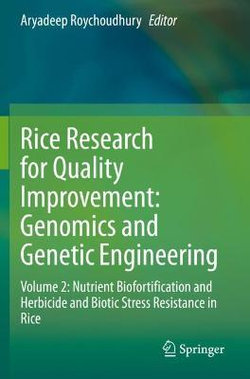Chapter 1. Understanding the mechanism of host-pathogen interaction in rice through genomics approaches.- Chapter 2. Genetic engineering and Genome editing strategies to enhance resistance of rice plants to diseases: a review of progress and future prospects.- Chapter 3: Transgenic rice live against bacterial blight.- Chapter 4. Genetic Engineering of Cultivated Rice for Viral Resistance.- Chapter 5. Genomics and genetic engineering for polyamine-mediated tolerance of rice against pathogen infection.- Chapter 6. Genomics and genetic engineering of rice for resistance to different insect pests.- Chapter 7. Genetic engineering of rice for resistance to insect pests.- Chapter 8. Increasing rice grain yield under biotic stresses: mutagenesis.- Chapter 9. Temporal and spatial dynamics of microbial communities in a genetically modified rice ecosystem.- Chapter 10. Genetic Engineering for Developing Herbicide Resistance in Rice Crops.- Chapter 11. An insight into the factors regulating flowering in rice: From genetics to epigenetics.- Chapter 12. Breeding and Bioengineering of male sterility in rice.- Chapter 13. Male sterility system for hybrid rice breeding and seed production.- Chapter 14. Advancement in tracking down nitrogen use efficiency in rice: Molecular breeding and genomics insight.- Chapter 15. Improving Water use Efficiency and Nitrogen use Efficiency in Rice through Breeding and Genomics Approaches.- Chapter 16. Rice breeding and genomics approaches for improving water and nitrogen use efficiency.- Chapter 17. Aromatic rice: biochemical and molecular basis of aroma production and stress response.- Chapter 18. Genomics and genetic engineering of rice elucidating cross-talk between stress signaling and nutrition enhancement via regulation of antioxidant, osmolyte and metabolite levels.- Chapter 19. Genetically modified rice stacked with antioxidants for nutrient enhancement and stress tolerance.- Chapter 20. Breeding and QTL mapping for γ-oryzanol and nutrition content in rice.- Chapter 21. Genetic Enhancement of Nutritional Traits in Rice Grains through Marker Assisted Selection and Quantitative Trait Loci.- Chapter 22. Breeding approaches to generate biofortified rice for nutritional enhancement.-Chapter 23. Ameliorating nutritional, protein and vitamin content on rice seed through classic mating and advanced genetic technology.- Chapter 24: Genetic engineering of rice to fortify micronutrients.- Chapter 25. Golden Rice: genetic engineering, promises, present status and future prospects.- Chapter 26. Biofortification of rice with iron and zinc: progress and prospects.- Chapter 27. Biofortification of iron, zinc and selenium in rice for better quality.- Chapter 28. Micronutrient biofortification in rice for better quality.- Chapter 29. Rice Genetic Engineering for Increased Amino Acid and Vitamin Contents.- Chapter 30. Biofortification of iron, selenium and zinc in rice for quality improvement.- Chapter 31. Quantitative trait loci for rice grain quality improvement.- Chapter 32. Improvement of rice quality via biofortification of selenium, iron and zinc and its starring role in human health.- Chapter 33. Improvement of rice quality via biofortification of micronutrients.- Chapter 34. Involvement of policy makers, public acceptance and commercialization of nutritionally enhanced and genetically modified rice.-




Share This Book: